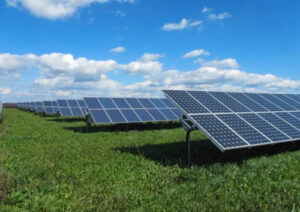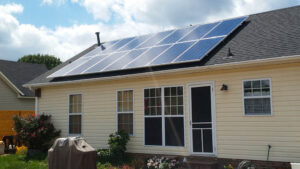More Universities Should Invest in Solar Energy: What Holds Them Back?
 As a student at a small women’s college in North Carolina, I work to see changes on our campus that reflect the ideals and values that Meredith College promotes in its pronouncements and marketing. I want to see my administrators uphold priorities that will provide the most authentic learning environment possible, and commit to taking visible steps toward a greener campus culture. Such actions would affect all Meredith students. A commitment to clean energy would demonstrate a credible concern for the climate crisis and solidify the college’s claims to sustainability and to racial and environmental justice.
As a student at a small women’s college in North Carolina, I work to see changes on our campus that reflect the ideals and values that Meredith College promotes in its pronouncements and marketing. I want to see my administrators uphold priorities that will provide the most authentic learning environment possible, and commit to taking visible steps toward a greener campus culture. Such actions would affect all Meredith students. A commitment to clean energy would demonstrate a credible concern for the climate crisis and solidify the college’s claims to sustainability and to racial and environmental justice.
In my efforts to advocate for sustainable actions on Meredith’s campus, I connected with mentors and professors who have been pushing for solar installations for years. Their passion for change sparked my initial interest in finding a way to integrate solar into Meredith’s utility systems; it continues to provide insights into how Meredith College can improve its energy efficiency. More specifically, how can we, as students, compel our universities to take meaningful action on the climate crisis?
I am concerned with how my campus community at Meredith College can become more energy efficient through solar installations. They provide a host of teaching and learning opportunities and would showcase the college’s core values and vision. For me, then, it is vitally important to understand where the priority for clean and renewable energy lies in the financial interests of the college administration, because the younger generation of sustainably-minded individuals who are passionate about preserving global climate stability deserve to be represented by the universities they are funding.
To see a boom in solar investment and cost-effective technologies will mean facing the obstacles of full-renewable energy reliance head-on and recognizing the danger of continued fossil fuel dependence. On college campuses across the country, as well as in my own city of Raleigh, North Carolina, there has been a slow but steadily growing urge to push our college communities forward to align the university’s values with those of their diverse student populations. In this generation, students prioritize the health of our planet more than ever before and have begun to speak out about the reality of environmental injustices.
 Solar energy is storming to the forefront of power these days. As a result, it’s hard to drive through a middle-class neighborhood without spotting rooftops here and there gleaming with reflected sunlight. It’s hard to overstate how much more accessible solar energy has become. It’s a common experience to see sprawling rows of solar arrays that extend across the wide rural fields of Eastern North Carolina, tucked amid trim rows of soybeans and cotton. Since 2008, solar use has risen to a promising 62.5 gigawatts in the US, with the potential to provide enough power for approximately 12 million average-sized American homes. If photovoltaic panels were installed on a mere 0.6% of the nation’s total land area, there would be enough electricity to light up the entire United States- that is a lot of power.
Solar energy is storming to the forefront of power these days. As a result, it’s hard to drive through a middle-class neighborhood without spotting rooftops here and there gleaming with reflected sunlight. It’s hard to overstate how much more accessible solar energy has become. It’s a common experience to see sprawling rows of solar arrays that extend across the wide rural fields of Eastern North Carolina, tucked amid trim rows of soybeans and cotton. Since 2008, solar use has risen to a promising 62.5 gigawatts in the US, with the potential to provide enough power for approximately 12 million average-sized American homes. If photovoltaic panels were installed on a mere 0.6% of the nation’s total land area, there would be enough electricity to light up the entire United States- that is a lot of power.
 Photovoltaic solar panels (PV), the kind most often seen decorating the rooftops of homes and businesses, pack the extra punch of requiring no impact on land use. Their appeal has made them more cost effective than ever; the average cost of solar photovoltaic (PV) panels has dropped by almost 50% since the year 2014. However, problems arise when trying to convert to a baseload power system of complete reliance on the energy gained from (PV) solar. It remains costly for several reasons and energy storing is still an issue where (PV) systems cannot fill the need for power on cloudy days throughout the year. Current solar batteries on the market are unable to reliably store enough solar energy to counterbalance the losses after a spell of cloudy days.
Photovoltaic solar panels (PV), the kind most often seen decorating the rooftops of homes and businesses, pack the extra punch of requiring no impact on land use. Their appeal has made them more cost effective than ever; the average cost of solar photovoltaic (PV) panels has dropped by almost 50% since the year 2014. However, problems arise when trying to convert to a baseload power system of complete reliance on the energy gained from (PV) solar. It remains costly for several reasons and energy storing is still an issue where (PV) systems cannot fill the need for power on cloudy days throughout the year. Current solar batteries on the market are unable to reliably store enough solar energy to counterbalance the losses after a spell of cloudy days.
While solar production costs have experienced a significant drop in recent years, “soft costs”— expenses like permitting, financing, and customer acquisition— are beginning to comprise growing costs that don’t come to mind when considering the installation of a solar panel on your roof. These costs are now reaching 74% of total residential system costs, making it more difficult for lower or middle-income residents to integrate solar into their home energy systems, even counting the long-term benefits. This upfront cost is still too steep for many homeowners, businesses, and universities to scale, especially for larger buildings that use more energy, require more panels, and therefore see higher and higher initial prices.
 While the imperative for universities to embrace renewable energy in response to the climate crisis is clear, the impact of the fossil fuel industry on minority communities, particularly in North Carolina, makes it ever more urgent as an issue of racial and environmental justice. Those who experience the disproportionate effects of toxic emissions also suffer the consequences of respiratory diseases and other health problems. In the US, African-Americans suffer over 54% higher rates of diseases associated with air pollution in comparison to the rest of the country’s population. People living in these largely minority areas, where fracking and drilling for oil and natural gas is most prevalent, have increased rates of asthma, bronchitis, heart disease and lung cancer, among many other illnesses, which are caused by their direct exposure to tiny toxic particulates in the air as a result of fossil fuel emissions.
While the imperative for universities to embrace renewable energy in response to the climate crisis is clear, the impact of the fossil fuel industry on minority communities, particularly in North Carolina, makes it ever more urgent as an issue of racial and environmental justice. Those who experience the disproportionate effects of toxic emissions also suffer the consequences of respiratory diseases and other health problems. In the US, African-Americans suffer over 54% higher rates of diseases associated with air pollution in comparison to the rest of the country’s population. People living in these largely minority areas, where fracking and drilling for oil and natural gas is most prevalent, have increased rates of asthma, bronchitis, heart disease and lung cancer, among many other illnesses, which are caused by their direct exposure to tiny toxic particulates in the air as a result of fossil fuel emissions.
Making the change to renewable energy should be our number one priority since the health and well-being of our communities depends on it. Communities need to invest in research that seek solutions to the technical problems of solar battery technology and find ways to lower the “soft costs” that make solar more expensive. It is essential to moving our energy usage in a zero-emission direction.
Though an all-encompassing breakthrough has yet to fix these problems keeping renewable energies like solar, wind, hydropower and geothermal from replacing fossil fuels for good, there are emerging opportunities that could cut lingering high prices of cleaner energy sources and make it easier to push for a widespread clean energy transition.
 In 2017, Stanford University developed a more cost-effective alternative to the rare and drastically less affordable lithium-ion battery, storing the same amount of energy in their innovative sodium-based battery while lowering the cost by less than 80%. Because solar energy is one of the renewable energies similar to wind in its reliance on unpredictable and unreliable environmental factors, the advantage of “low-cost but high-performance” batteries would be a game changer, ensuring cheaper material harvesting and the possibility of implementing solar in previously unfavorable locations. Energy storage capacity will soar with possibilities as excess power will be stored during peak sunlight hours and throughout the peak times of the year. Excess energy will be saved for those gloomy cloudy-day spells when conditions would have rendered useless solar panels without an effective storage mechanism. While Stanford’s sodium-battery still has obstacles to overcome before it can be put on the market as a viable alternative to the lithium-ion battery, it demonstrates the promise of advances that will provide more and more cost-effective options.
In 2017, Stanford University developed a more cost-effective alternative to the rare and drastically less affordable lithium-ion battery, storing the same amount of energy in their innovative sodium-based battery while lowering the cost by less than 80%. Because solar energy is one of the renewable energies similar to wind in its reliance on unpredictable and unreliable environmental factors, the advantage of “low-cost but high-performance” batteries would be a game changer, ensuring cheaper material harvesting and the possibility of implementing solar in previously unfavorable locations. Energy storage capacity will soar with possibilities as excess power will be stored during peak sunlight hours and throughout the peak times of the year. Excess energy will be saved for those gloomy cloudy-day spells when conditions would have rendered useless solar panels without an effective storage mechanism. While Stanford’s sodium-battery still has obstacles to overcome before it can be put on the market as a viable alternative to the lithium-ion battery, it demonstrates the promise of advances that will provide more and more cost-effective options.
Until then, universities have a responsibility to lead the clean energy revolution as symbols of cutting-edge research and technological advancement in their communities. College campuses operate like small, localized cities in terms of energy consumption. A higher rate of college enrollment has resulted in rising operational costs and led to higher tuition for students, a kind of cyclical downward spiral that only results in higher energy demands. Thus universities, with their small ecosystems teeming with ingenuity and innovation, are prime places for renewable energy to flourish and dominate an energy landscape where non-renewables still drive up tuition costs and generate unnecessary expenses for colleges and universities.
How might renewable solar benefit and flourish on my own Meredith College campus? I recently spoke with Dr. Matt Stutz, an Associate Professor of Geoscience. According to Dr. Stutz, one of the most valuable benefits of solar energy would be sparking a student’s interest and encouraging them to investigate and learn more about the greener behavior and technology. From an educational standpoint, Stutz said, “Knowledge is really important in setting goals and trying to change peoples’ behaviors.” For Stutz, solar installations are also strong symbols of the college’s values and vision.
“It is a very tangible and visible sign that we value sustainability and it’s a statement to students who want to come here, that we value sustainability and they can learn more about sustainability at Meredith by the way that we operate the campus, that we do use renewable energy, that we do have composting programs, that we are always trying to find ways to improve on our sustainability efforts.”
Among university students surveyed for the potential benefits following more solar energy integration on their college campus, the most commonly expressed answers were that it would help the environment and create continuing publicity and marketing potential for environmental sustainability majors, opportunities for teaching and research, and long-term financial savings. Universities in the prime states for maximum yearly sun exposure, such as California or Arizona, have the greatest ability to rely on solar for baseload power and have already seen the positive effects roll in as they lower total energy costs, cut emissions, and grow educational opportunities on their campuses. But Dr. Stutz hopes that with student involvement, those positive impacts can be extended to Meredith’s campus, and avoid remaining limited to universities and colleges in areas with continuous hours of year-round sunshine. He explains with enthusiasm that:
“In a space where there is a visible symbol like that (solar) you essentially start learning about why it’s there. The campus itself can be a teaching environment. So that’s one way, the other way is that you can use it to do experiential learning, you can have a physics class measure the amount of voltage generated by that current and you can calculate how much energy the college is saving by not having to buy that energy from the utility company. So, there are lots of different ways you can see that value coming out in educational opportunities.”
Dr. Stutz’s course in Environmental Resources conducts a greenhouse gas audit every fall, measuring how much energy the campus has used and then applying that knowledge with the options Meredith students have at their disposal to reduce energy usage. He states, “(…) like solar panels, you can use that as a way to teach methods to promote the continued effort of lowering our collective carbon footprint.”
Currently, the primary hurdle standing in the way of installing solar on universities campuses is the hefty initial investment costs. A way to overcome this is supplemental grant funds and incentives. There are so many new opportunities for colleges like Meredith to receive incentives from companies like Duke Energy, mainly because of campuses non-profit status and massive energy consumption. The more energy a building or system uses and the more solar panels they install, the more money they would receive from the Duke Energy incentive program.
But increase student interest and for the campus to reap these benefits, according to Dr. Stutz, visibility is key:
“I think students would be more willing to try and promote those kinds of projects, once they see that we have some evidence or proof of it already sitting on a rooftop or free-standing in the middle of an educational space.”
Meredith already is working to save energy, Stutz says, but in ways that are hard to show off:
“Those other improvements show up in our data, when we look at the energy usage and we’ve seen the energy usage decrease, that shows up pretty obviously, but that’s a story not a lot of people know because we were replacing things like the chiller and aspects of our heating system. But having something visible, I think, is important, because it’s a better communicator than people know, you know they see a solar panel and know immediately what it’s there for.”
We are in a time of great social upheaval where students are calling upon their leaders to both tackle the climate crisis and dismantle the systems of white supremacy that are pervasive throughout our society. In embracing solar energy, Meredith College and universities across the country can do both.
Emma Fry – Rachel Carson Council Fellow
 Emma Fry is a rising sophomore at Meredith College pursuing a double major in Environmental Science and Biology with a minor in Professional Writing. Her RCC Fellowship project is promoting solar energy on campuses. [email protected]
Emma Fry is a rising sophomore at Meredith College pursuing a double major in Environmental Science and Biology with a minor in Professional Writing. Her RCC Fellowship project is promoting solar energy on campuses. [email protected]
References:
https://www.sustainable.org/environment/energy/1629-solar-on-college-campuses
https://rc.library.uta.edu/uta-ir/handle/10106/27551
https://futurism.com/stanfords-cheap-batteries-new-age-energy
https://www.bakerhomeenergy.com/blog/2016-08-19/why-and-how-solar-power-colleges-and-universities
https://energynews.us/digests/epa-study-minorities-are-disproportionately-impacted-by-air-pollution/
https://www.scientificamerican.com/article/graphic-science-health-care-burden-of-fossil-fuels/
![]() The Rachel Carson Council depends on tax-deductible gifts from concerned individuals like you. Please help if you can.
The Rachel Carson Council depends on tax-deductible gifts from concerned individuals like you. Please help if you can.
![]() Sign up here to receive the RCC E-News and other RCC newsletters, information and alerts.
Sign up here to receive the RCC E-News and other RCC newsletters, information and alerts.